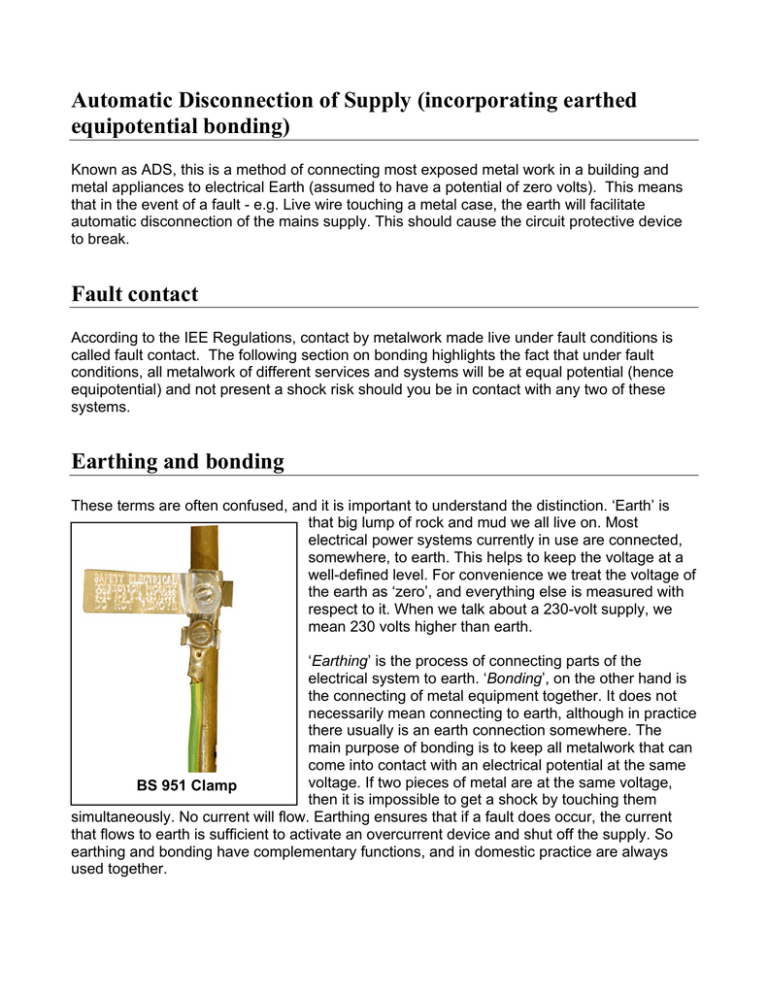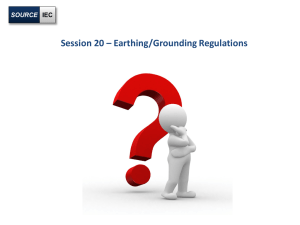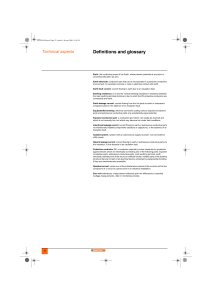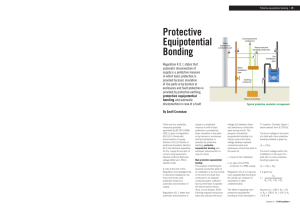Automatic Disconnection of Supply
advertisement

Automatic Disconnection of Supply (incorporating earthed equipotential bonding) Known as ADS, this is a method of connecting most exposed metal work in a building and metal appliances to electrical Earth (assumed to have a potential of zero volts). This means that in the event of a fault - e.g. Live wire touching a metal case, the earth will facilitate automatic disconnection of the mains supply. This should cause the circuit protective device to break. Fault contact According to the IEE Regulations, contact by metalwork made live under fault conditions is called fault contact. The following section on bonding highlights the fact that under fault conditions, all metalwork of different services and systems will be at equal potential (hence equipotential) and not present a shock risk should you be in contact with any two of these systems. Earthing and bonding These terms are often confused, and it is important to understand the distinction. ‘Earth’ is that big lump of rock and mud we all live on. Most electrical power systems currently in use are connected, somewhere, to earth. This helps to keep the voltage at a well-defined level. For convenience we treat the voltage of the earth as ‘zero’, and everything else is measured with respect to it. When we talk about a 230-volt supply, we mean 230 volts higher than earth. ‘Earthing’ is the process of connecting parts of the electrical system to earth. ‘Bonding’, on the other hand is the connecting of metal equipment together. It does not necessarily mean connecting to earth, although in practice there usually is an earth connection somewhere. The main purpose of bonding is to keep all metalwork that can come into contact with an electrical potential at the same voltage. If two pieces of metal are at the same voltage, BS 951 Clamp then it is impossible to get a shock by touching them simultaneously. No current will flow. Earthing ensures that if a fault does occur, the current that flows to earth is sufficient to activate an overcurrent device and shut off the supply. So earthing and bonding have complementary functions, and in domestic practice are always used together. The two main types of bonding we will encounter are main equipotential bonding and supplementary bonding. Main equipotential bonding is when we connect all the incoming services, such as water and gas, and structural steelwork to a main earthing terminal (illustrated). Supplementary bonding is the practise of bonding together exposed conductive parts and extraneous conductive parts ensuring a difference in potential under fault conditions doesn’t occur. Sizing of protective conductors The IEE Regulations state a standard size for conductors protecting a circuit in table 54G. These figures are pre calculated for us but it is important if you are unsure to use alternative methods of sizing. The table states the following: c.s.a. of phase conductor c.s.a. of protective conductor Up to 16mm2 Same as phase conductor Greater than 16mm2 but less than or equal to 35mm2 16mm2 Greater than 35mm2 Phase size halved* *where phase size does not half, the next size available should be used, for example a phase conductor with a c.s.a. of 90mm2 would have a cpc/earth of 50mm2 Earthing System Components Bonding Conductor - A protective conductor providing equipotential bonding Circuit Protective Conductor (C.P.C.) - A protective conductor connecting exposedconductive-parts of the equipment to the main earthing terminal Earth - The conductive mass of earth, whose electrical potential at any point is taken as zero Earth Electrode - A conductor or group of conductors in close contact with, and providing an electrical connection, to earth Earth Fault Current - A current that flows to earth under fault conditions Earth Fault Loop Impedance - The impedance of the earth fault current loop starting and ending at the point of an earth fault. Earth Leakage Current - A current which flows to earth, or to extraneous conductive parts, in a circuit which is electrically sound Equipotential (Earthed) Zone - A zone (site, installation, premises) within which exposed conductive parts and extraneous conductive parts are maintained at an equal electrical potential by bonding, such that, under fault conditions, the difference in potential between simultaneously will not cause electric shock Earthing Conductor - A protective conductor connecting the main earthing terminal of an installation to an earth electrode or other means of earthing Equipotential Bonding - An electrical connection maintaining various exposed conductive parts and extraneous conductive parts at an equal potential Exposed Conductive Part - A conductive part of equipment which can be touched and which is not a live part but may become so under fault conditions. Extraneous Conductive Part - A conductive part liable to introduce a potential, generally earth potential, and not forming part of the installation Main Earthing Terminal - The terminal or bar provided for the connection of protective conductors, including equipotential bonding conductors, to the means of earthing.


